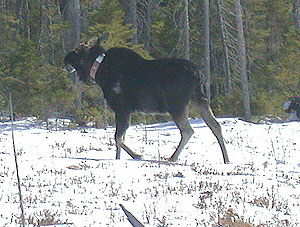|
Audio
Photos
Your Voice
|
Moose research
March 6, 2003
 |
| A bull moose walks away after being fitted with a collar. (Photo courtesy Pam Coy, Minnesota DNR) |
Isabella, Minn. — Half-a-dozen big four-wheel-drive pickups are parked at a boat landing on McDougal Lake.
It's midway between Two Harbors and Ely, in the heart of the Superior National Forest. The forest is twice the size of Delaware.
At the edge of the frozen lake, men in conservation officer uniforms are standing around a small fire. It's 25 degrees.
They're waiting to hear from the helicopter. The crew on the helicopter is shooting moose with a tranquilizer gun. They need to get up close to learn more about them.
Scientists think more moose could be living in this area.
 | |||
Mike Shrage is a biologist with the Fond du Lac band of Chippewa. He says they'd like to know why there aren't more moose here.
"Wolves, bears, lack of habitat, hunting and other kinds of human-related mortality, automobile accidents," he lists the possible reasons.
Shrage is listening to a radio cradled in a canvas holster on his shoulder. He cocks his head to catch every word.
"There's three of them there." the radio squawks.
The helicopter crew has spotted some moose.
"Yeah, I think they're bulls," comes another message.
Mike Shrage listens with satisfaction.
"These are three bulls," he says. "It's not uncommon this time of year, you'll get small groups of them hanging together for awhile. Little bachelor groups." The helicopter crew will try to chase one of the moose into an open area, like a frozen lake, where they can get an easy shot.
"And if it lays down right in the lake," Shrage says, "they can set the helicopter down on the ice next to it. It makes everything a lot easier."
"Yeah, he's gonna hopefully drop in the spot where they can get right to him," the radio seems to echo Shrage's thoughts.
 | |||
Shrage says the helicopter crew has shot a moose with tranquilizing drugs, and they're waiting for the drugs to take effect.
The helicopter drops off a crew member to stay with the moose, and comes back to the boat landing to pick up a radio collar.
From the air, the curving lakeshores and winding rivers enclose patches of trees that stretch to the horizon. The helicopter crew has searched an area roughly 36 square miles today, and they've only seen about a dozen moose.
Counting moose is always a challenge. A recent survey in this area showed a drop from 5,000 to 4,000 animals in one year. But researchers admit there could be a 25% margin of error in those figures. The collaring project will make counts more accurate.
Three biologists are gathered around the latest moose to be fitted with a collar. He's a mature bull. He's lying on his side in the middle of a huge frozen swamp.
 | |||
He's blindfolded to make the process less stressful. He seems to snore, while the biologists poke and prod.
They take blood samples to check on hormones and blood chemistry, and to look for disease. They also pull a tooth to send to a lab. They can get an exact age by measuring the rings on the tooth.
Glenn Delgiudice takes notes on the animal's fat reserves. That's a good indication of its overall health.
"Do you see fat in certain areas where you'd be expected to have a fat depot at certain time of year or is it very thin and devoid of fat?" Delgiudice explains the signs he looks for. "How prominent are the ribs, the backbone, the loin? Are they rounded shoulders, or angular shoulders, indicating more malnutrition?"
Delgiudice even uses an ultrasound machine to measure the fat in the moose's rear end.
"Rump fat is one of the main fat depots of these animals, and also one of the first to go," he says. "They mobilize their fat depots generally in a sequence. So we measure the depth of the fat with ultrasound."
 | |||
Another key indicator of the animal's health is the condition of its hair. This moose has most of its hair. They aren't all so lucky. Some of them have scratched a lot their hair off.
Yesterday the biologists saw a calf that had only 25% of its hair. "So that one's been rubbing and scratching for a long time," Delgiudice says. "And when they're doing that rubbing and scratching and biting, they're not foraging, and it can drain them over time."
The collar has to fit just right. If it's too loose, a moose can get a foot caught in it. If it's too tight, it can bind, especially in the fall mating season when the bulls' necks get thicker.
"Not too snug, not too loose," the scientists tell each other as they fasten the collar in place.
 | |||
Finally the moose is given an antidote to the tranquilizer, pain-killer, and sedative that have kept him immobile for about half an hour.
"You'll see his ears twitch, and he'll start to lift his head," Delgiudice says. "The moose are better at getting up than deer typically. They just get up, loosen up a little bit, and then lope away. See his ears twitch a little bit there."
The moose struggles up, stands for a minute, and then saunters off toward the trees.
That's moose number five for the day. The team wants to collar 60 moose, and track them for five years.
It'll tell them what kills these moose and what's keeping the population from growing.
|
News Headlines
|
Related Subjects
|
